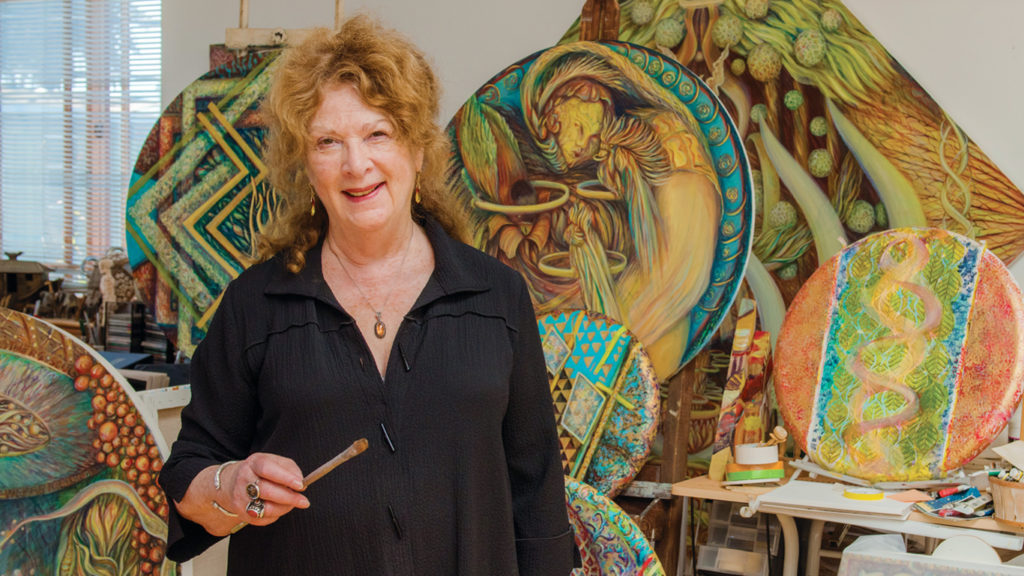
When Gilah Yelin Hirsch first read her mother’s 70 diaries and discovered the extent of the physical and psychological abuse she had endured from infancy to the age of 16, rather than loathing her, she felt “love, empathy and compassion for her mother,” the celebrated Canadian author Shulamis Yelin.
“I grew to admire her for all that she had accomplished despite the extremes of her mental illness and her very difficult life,” said Hirsch, professor of art at California State University, Dominguez Hills (CSUDH). “The greatest difficulty in reading the diaries was seeing the severity and depth of her suffering, and reading how although on a certain level I and others who were close to her may have been loved, she could not restrain the abuse throughout her life.”
Hirsch compiled many of her mother’s published and unpublished stories, family photographs and selected excerpts from the diaries–written by Yelin from the age of 13 to 89–for her new book “Demonic to Divine: The Double Life of Shulamis Yelin.”
Hirsch’s mother remains one of Canada’s most beloved writers. Her most acclaimed book of poetry is “Seeded in Sinai,” while “Shulamis: Stories of a Montreal Childhood” is her most famous book of stories. Her works are translated into several languages and are often required reading in Canadian schools.
 Following Yelin’s death in 2002, Hirsch inherited the diaries, which document a highly gifted woman’s struggle to coexist with her abusive nature, self-loathing, and overwhelming despair while creating a significant literary legacy. As Yelin’s talent became widely recognized she traveled the world as a prominent writer. Her archives contain “letters of respect” from many world-renowned authors.
Following Yelin’s death in 2002, Hirsch inherited the diaries, which document a highly gifted woman’s struggle to coexist with her abusive nature, self-loathing, and overwhelming despair while creating a significant literary legacy. As Yelin’s talent became widely recognized she traveled the world as a prominent writer. Her archives contain “letters of respect” from many world-renowned authors.
Book Signing: Gilah Yelin Hirsch will sign her book “Demonic to Divine: The Double Life of Shulamis Yelin” on April 29, from 4:30 to 6 p.m., University Library-South, 5th floor.
Writing the multi-layered book took Hirsch nearly 12 years to complete. She found difficulty in selecting material from the diaries that represent the sheer scope of her mother’s suffering, as well as choosing what Hirsch called Yelin’s “humorous, often hilarious, delicious family-friendly stories about growing up in Jewish immigrant society in Montreal.”
“While reading the diaries and seeing the inception of these stories alongside her daily agony, I decided to capture this simultaneous duality in a book about her life as seen through her ‘double’ personality,” said Hirsch. She would not have disclosed the intimate details in the diaries had her mother not written several times that she wanted the material published and believed it was her “greatest literary legacy.”
Yelin was compelled to write in the diaries daily as they became the “other,” the creative outlet that alleviated some of the deepest angst.
Even after years of abuse, Hirsch continued to remain in contact with her mother throughout the years, despite the continuing difficulties of their relationship.
“I suggested various joint therapies, but to no avail. My childhood was horrific. The diary entries in the hospital describe Shulamis’ extreme violence, even to her 8-month-old baby,” said Hirsch. “Between my father’s tragic physical deterioration due to a car accident that triggered the degeneration of the motor limbs, and my mother’s mental illness, my sense of compassion for all who suffer developed, as did my hope to help others.”
The Renaissance of Gilah Yelin Hirsch

Hirsch has an extensive range of artistic abilities. Along with being an accomplished art educator and writer, she is a respected photographer, videographer, filmmaker and painter whose work has been exhibited internationally since 1968.
Her paintings have been acquired by major public and private collections, including the Skirball Museum in Los Angeles, the Alexander Braun Collection in Budapest, and the University of California Medical Arts Collection. Her unusually crafted and appointed home in Venice has been deemed an art and architectural destination and has been opened to tours arranged by various art related institutions.
As a child, seeing her mother at the typewriter and “pages of manuscripts covering the floor” had a substantial influence on Hirsch’s interest in writing. She wanted to grow up to be a writer and psychologist, and at the age of 6 had already published several essays.
As she grew she also became interested in science, and continues to study many disciplines today. Her articles and theoretical papers have been published in scholarly journals worldwide. For more than three decades, Hirsch has developed a series of hypotheses showing a relationship between physiological systems and perceptual patterns that affect behavior, health and healing.

Hirsch credits her mother for not only being aware of her illness–Yelin described it at 13 as when the “moods take over”–and seeking help from the “fledgling field of psychiatry,” but also for committing herself to a mental facility in the early 1960s.
“I have included some of her writings from the hospital in what she calls ‘Tales from the Looney Bin,’” said Hirsch. “One of the threads that I followed in the diaries is on the growth of the psychiatric profession and its inability to treat her effectively throughout her life.”
Based on her research, Hirsch believes her mother also used her diaries to not only record daily events, but to consciously benefit from the healing potential of the creative arts.
“When one looks at the history of the arts and civilization, it is clear that many of our brightest, most creative people have suffered some form of mental illness that we may now call borderline, bipolar, schizophrenia, autism, etc,” said Hirsch. “I used to say to my mother, ‘If only I could bottle limelight, I would anoint you daily.’ She was always fabulous when performing, reading, or on national TV, but the moment she was out of the limelight, the other agony would appear.”